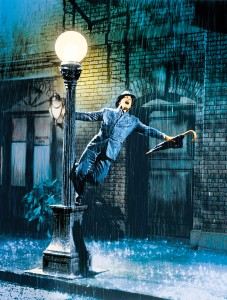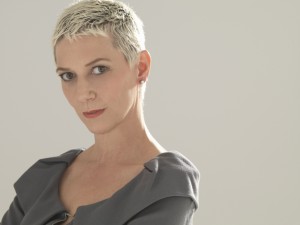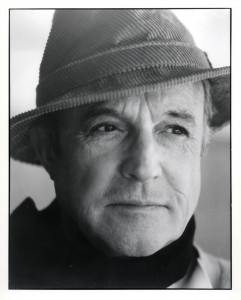Teasing apart the movie musical a few years back, cultural critic Gilberto Perez wrote that each successful musical positions one of two figures of the artist in the fore: either the performer or the director. Sometimes, as in “The Band Wagon,” we actually see the two figures characterized on film, fighting for prominence. But usually, one of the two figures subtly dominates the artistic creation and lingers in our minds. “Whereas in the Astaire musical the artist is the performer,” Perez writes, ” the artist in a Berkeley musical is above all the director (literally above all in those overhead shots of performers arranged in geometric formations).”
No mention of Gene Kelly here, however. (Astaire always seems to get more validation in intellectual circles.) But even in its omission, Perez’s argument certainly reflects on the challenge of defining Gene Kelly. It takes over two hours in “Gene Kelly: The Legacy,” a touring show created by Kelly’s widow — historian and biographer Patricia Ward Kelly — to make it possible for our human brains and hearts to absorb the fact that Kelly was both a triple-threat performer (singing, dancing, and acting) as well the director and choreographer on some of his best known films. I interviewed Patricia Ward Kelly this past week to talk about her show; a version of the piece below ran in the Orange County Register. It’s also a great romance story.
“Gene Kelly: The Legacy”
Behind the scenes of a 1985 Smithsonian production, she was a dark-haired 26-year-old scholar of Herman Melville thrown together with the beloved dancer and matinee idol Gene Kelly, 73, who’d come to D.C. to provide narration for the documentary. Raised in a bookish family from a Colorado cow town, she’d never actually seen a thing he’d done. But the genial elder statesman of Hollywood and Broadway, a devout bachelor since the early death of his 2nd wife Jeanne Coyne, Kelly instantly bonded with the young writer over poetry and soon after brought her to Los Angeles to help with his autobiography. And in what sounds like an old movie plot, Patricia Ward and Gene Kelly — working together to accurately document his enormous artistic contributions and capture the real feeling of his life story — fell in love, married and shared a tender, arts-filled romance that lasted until his death in 1996.
Yet while there’s rarely a dream script for widowhood, the ever-changed Patricia Kelly clearly knew her marching orders as official biographer and sole trustee of the Gene Kelly image after her husband’s death. In a phone interview last week, she explained that due to crediting lapses and decades of misinformation, her late husband’s game-changing work as a studio choreographer and film director isn’t common knowledge, and it is now her scholarly role and passion to correct that. In the decade plus since his Kelly’s death, she’s organized her L.A. townhouse with nearly 85 filing cabinets worth of archival material to support both the long-awaited biography as well as the unplanned one-man show that’s “grown like topsy,” as she says (quoting Mark Twain).
Playing shows this fall in Laguna and Vista CA, then Berkely MI, Nashville TN and Europe in 2015, “Gene Kelly: The Legacy” features Patricia Kelly — now a regal, honey-voiced blonde — narrating a two-hour-plus selection of film favorites plus rare audio and movie clips that recount his biography and demonstrate his efforts to energize dance on film. Though she loves writing about him, “there’s nothing like seeing Gene in 18-by-32 glorious Technicolor,” she says, “and I think it really heightens the storytelling.”
Patricia Kelly admits the “hybrid” show can be a hard sell at first: “People think: ‘Why would I want to listen to his wife?….God what is she going to be…110?’ They have no idea how cerebral he was, or what I’m about, or the nature of our relationship.” She compares Kelly’s arts tutelage to Sheilagh Graham’s literary education from F. Scott Fitzgerald outlined in “College of One.”
“I had to learn about Martha Graham and Charles Weidman,” Kelly explains, “and I had to learn about the camera and Technicolor and what a 3-strip Technicolor camera did. Imagine! I couldn’t have gone to USC and gotten this education. I had a history of dance, a history of Broadway, a history of music, a history of filmmaking — it was like Cinematography 101 every night. And I was a sponge, like Gene was a sponge, who soaked it all up.”
Using clips of Kelly’s directing work in “On the Town” and “Singing in the Rain” and his choreography for “An American in Paris,” the show demonstrates how his street-scene settings enabled room for careful, active camera work that could reflect the choreography’s velocity. As well, Kelly felt that dance numbers must segue from the narrative. “‘Singing in the Rain’ is probably your classic example,” Kelly says. “Those opening bars that we all know so well around the world, those don’t exist in the original [score]. And Gene said to the composer Roger Edens “How do I get in to this number?” and Edens gave him that opening vamp. And that’s the classic moment, it takes you right in: He’s in love, he’s kissed her, he waves off the cab, and you hear the “Doo-doo dod doo…” then he goes off and nobody’s questioning that he’s singing and dancing in the rain. And it conveys joy and love in every language around the world. ”
Ever the scholar, Patricia Kelly checked her husband’s recollections against primary source documents in USC’s Arthur Freed collection and interviewed eyewitnesses any chance she got. “I did cross-sections wherever I could. I learned very early not to trust the printed word,” she explains. With “Singing in the Rain,” she debunks rumors about milk being used to enable better ‘rain’ or that Gene Kelly’s taps were dubbed by someone else. Mostly, she wants his directorial artistry properly credited. Though the film was co-directed by Kelly and his protégé Stanley Donen , IMDB and others alphabetize names, thus placing Donen first. Sometimes Kelly’s name is missing completely. “I even line-edited things to see if the quotes were accurate in books, and they’re not. It’s criminal that these things go out as journalism. But I figure if you talk about them too much you really draw more attention….I just decided I’ll go out and create an accurate story.”
Gene Kelly’s loves, friends, and many artistic passions unfold in the show. “People love him up on the screen but they really have no sense of the dimensions to the man,” she adds. “I always used to say he was so much more interesting than he allowed people to know…. They can’t imagine that he was wearing all these hats.”
She realizes that audiences come to commune with her late husband, so initially she stepped offstage when the films began. Yet she received feedback asking her to stay, so she does that now, and says she never tires hearing the audience respond.
Perhaps audiences recognize, as Patricia Kelly herself does, that she bears a kind of “Pygmalion” imprint from her husband. It was all part of their learning together, she explains. “Teaching you how to walk and how to talk and how to wear your hat and how to tie a scarf and how to wear your skirt and what line is going to look good on you and how to stand for a photograph….It was an extraordinary ride.”
“Gene Kelly: The Legacy, An Evening with Patricia Ward Kelly.” Sept 29-30. 7:30 p.m. Monday and 7:30 p.m. Tuesday. Laguna Playhouse, 606 Laguna Canyon Road, Laguna Beach. $45. 949-497-2787. www.lagunaplayhouse.com
Upcoming tour dates at genekelly.org.



Gene Kelly was a master and an inspiration … of that there can be no doubt.